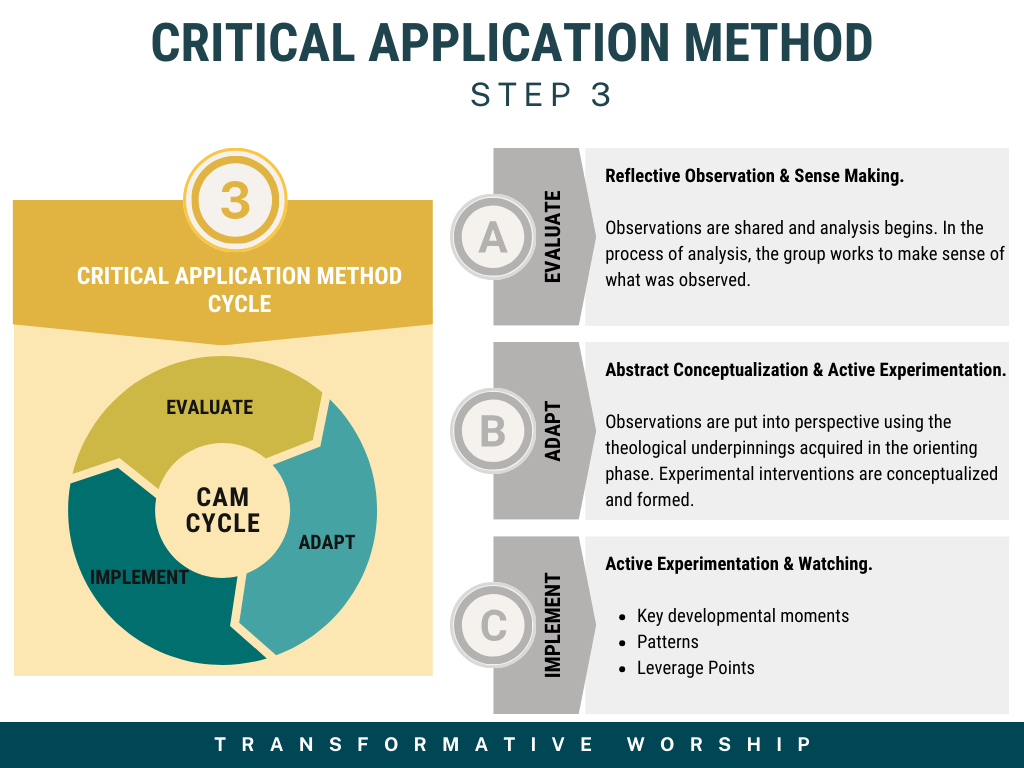The CAM Cycle is an interactive, continual process of evaluation, adaptation, and implementation. The first iteration of the CAM Cycle necessarily begins with the evaluation cycle where the foundational questions of the CAM process are assessed.
EVALUATION
The evaluation component of the CAM Cycle is rooted in the reflective observation element of Kolb’s cycle. Reflective observation recognizes that the core work of CAM comes from the combined reflections of the CAM team with regards to their concrete experiences with the intervention. The process of reflective observation recognizes that “learners understand situations and ideas from different points of view. They depend on objectivity, patience, and careful judgement but do not essentially take any action. The learners create an opinion on the bases of their feelings and thoughts.”[1] These observations are cultivated and then the process of sense-making begins. In sense-making, analysis is the process of making sense of what they are seeing.
In practice, the evaluation portion of the CAM Cycle asks the following questions:
Worldview Development:
- What vision of the good life is implicit in the liturgical practices of the church?
- What sort of person will I become after being immersed in this or that church liturgy?
Embodied and Communal:
- How do the liturgical practices of the church embrace humans as embodied creations?
- How do the liturgical practices of the church embrace humans as communal in nature?
Habituated and Desire Driven
- How do the liturgical practices of the church harness the fact that humans are desire driven?
- How do the liturgical practices of the church harness the fact that habituation is fundamental to how we are formed?
Transcendence
- How do the liturgical practices of the church create the expectation of God’s presence in worship?
ADAPTATION
After evaluation, the group begins the process of adaptation through the creation of interventions which are the active experimentations noted by Kolb’s process. In active experimentation, “learners show an active learning experience by experimenting with different situations.”[2] This is the part of the process in which analysis is synthesized into adaptive solutions that will be tested in the implementation phase.
The adaptation component of the CAM Cycle is grounded in the abstract conceptualization and active experimentation part of Kolb’s cycle. Abstract conceptualization is the process of using “ideas, logical approaches, and theories rather than interpersonal issues or feelings to understand the situation or problems. In most cases, they depend on systematic planning and building ideas and theories to solve practical issues and problems.”[3]
It is through the process of abstract conceptualization that potential interventions are developed and assessed for active experimentation in the implementation phase. Interventions can come in many different forms including the implementation of a new liturgy or the use of an evaluation tool such as a survey.
IMPLEMENTATION:
The implementation component of CAM is the time when active experimentation happens through the implementation of interventions as well as the time when observations are made regarding the implementation.
During the adaptation component of the CAM Cycle, the team recommends key active experiments aimed at solving issues that came to light in the evaluation component of the cycle. The implementation of active experiments is then actively watched by the team over a period of time. This watching process is the time for the collection of observations and data that will be analyzed and synthesized during evaluation. This period of reflective observation is the time in which the concrete experiences of the team members and reflections are moved forward to the evaluative process so that learning that can be made into action points.[4]
While watching the active experiments during the implementation process the team looks for:
- Key developmental moments – these are defined as “moments of clarity, strategic insight, serendipity, connections and/or movement.”[5]
- Patterns – are there patterns associated with “how and why each of the critical parts function the way they do, and how they interact to reinforce or stabilize other parts of the system.”[6]
- Leverage Points – these are strategic areas through which shifts can be created in the system. These are the areas where adaptations can be made.[7]
References:
[1] “Kolb’s Learning Cycle,” accessed October 28, 2023, https://www.structural-learning.com/post/kolbs-learning-cycle.
[2] “Kolb’s Learning Cycle.”
[3] “Kolb’s Learning Cycle.”
[4] “Kolb’s Learning Cycle.”
[5] Dozoiss, Langloiss, and Blanchet-Cohen, 41.
[6] Dozoiss, Langloiss, and Blanchet-Cohen, 36.
[7] Dozoiss, Langloiss, and Blanchet-Cohen, 37.

